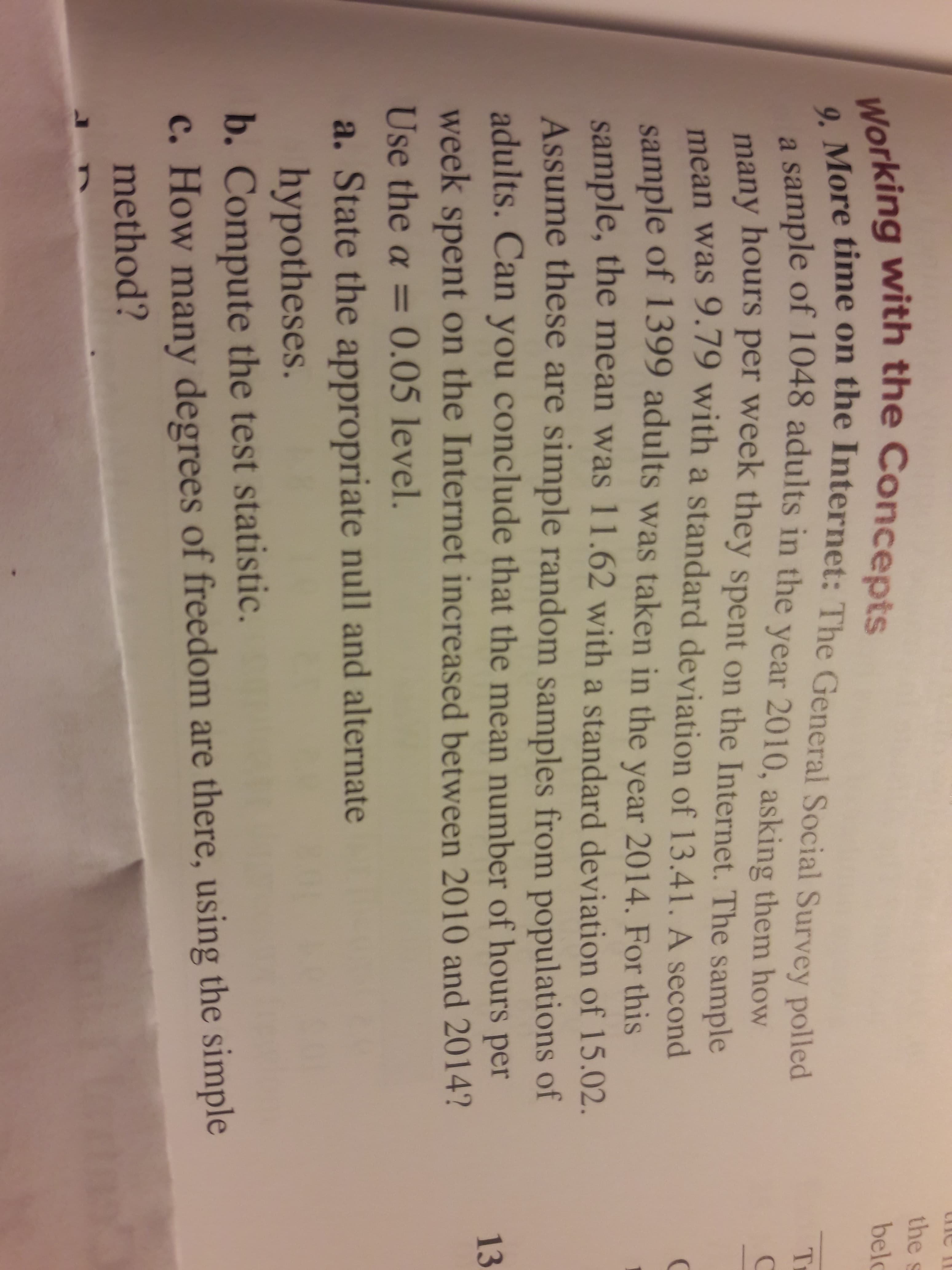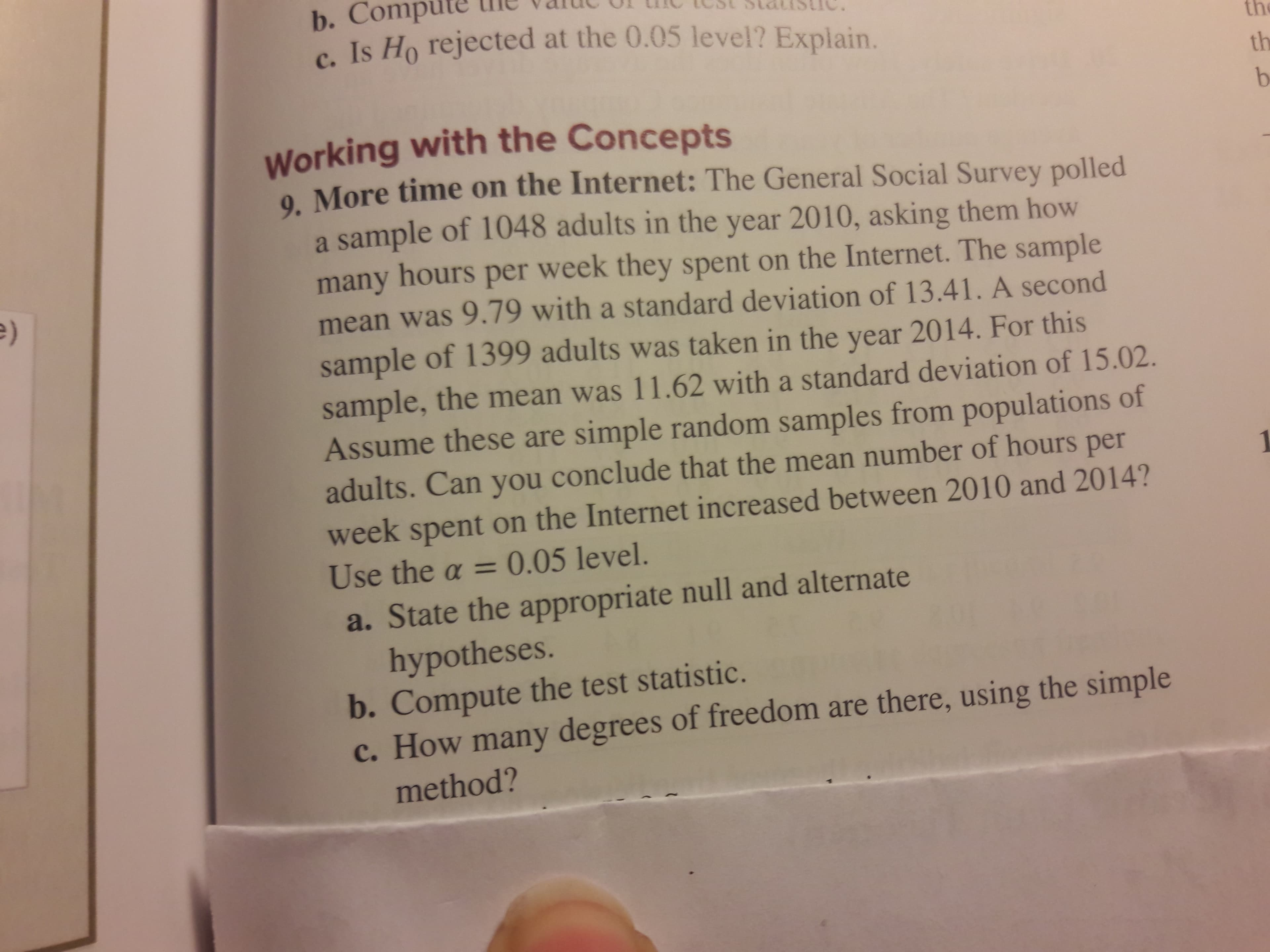thes Working with the Concepts bel 9. More time on the Internet: The General Social Survey polled a sample of 1048 adults in the year 2010, asking them how hours per week they spent on the Internet. The sample Tr many mean was 9.79 with a standard deviation of 13.41. A second sample of 1399 adults was taken in the year 2014. For this sample, the mean was 11.62 with a standard deviation of 15.02. Assume these are simple random samples from populations of adults. Can you conclude that the mean number of hours per 13 week spent on the Internet increased between 2010 and 2014? Use the a = 0.05 level. a. State the appropriate null and alternate hypotheses. b. Compute the test statistic. c. How many degrees of freedom are there, using the simple method? b. Com c. Is Ho rejected at the 0.05 level? Explain. th th b Working with the Concepts Q More time on the Internet: The General Social Survey polled a sample of 1048 adults in the year 2010, asking them how many hours per week they spent on the Internet. The sample mean was 9.79 with a standard deviation of 13.41. A second sample of 1399 adults was taken in the year 2014. For this sample, the mean was 11.62 with a standard deviation of 15.02. Assume these are simple random samples from populations of adults. Can you conclude that the mean number of hours per e) 1 week spent on the Internet increased between 2010 and 2014? Use the a = 0.05 level. a. State the appropriate null and alternate hypotheses. b. Compute the test statistic. c. How many degrees of freedom are there, using the simple method?
thes Working with the Concepts bel 9. More time on the Internet: The General Social Survey polled a sample of 1048 adults in the year 2010, asking them how hours per week they spent on the Internet. The sample Tr many mean was 9.79 with a standard deviation of 13.41. A second sample of 1399 adults was taken in the year 2014. For this sample, the mean was 11.62 with a standard deviation of 15.02. Assume these are simple random samples from populations of adults. Can you conclude that the mean number of hours per 13 week spent on the Internet increased between 2010 and 2014? Use the a = 0.05 level. a. State the appropriate null and alternate hypotheses. b. Compute the test statistic. c. How many degrees of freedom are there, using the simple method? b. Com c. Is Ho rejected at the 0.05 level? Explain. th th b Working with the Concepts Q More time on the Internet: The General Social Survey polled a sample of 1048 adults in the year 2010, asking them how many hours per week they spent on the Internet. The sample mean was 9.79 with a standard deviation of 13.41. A second sample of 1399 adults was taken in the year 2014. For this sample, the mean was 11.62 with a standard deviation of 15.02. Assume these are simple random samples from populations of adults. Can you conclude that the mean number of hours per e) 1 week spent on the Internet increased between 2010 and 2014? Use the a = 0.05 level. a. State the appropriate null and alternate hypotheses. b. Compute the test statistic. c. How many degrees of freedom are there, using the simple method?
Glencoe Algebra 1, Student Edition, 9780079039897, 0079039898, 2018
18th Edition
ISBN:9780079039897
Author:Carter
Publisher:Carter
Chapter10: Statistics
Section10.3: Measures Of Spread
Problem 26PFA
Related questions
Question

Transcribed Image Text:thes
Working with the Concepts
bel
9. More time on the Internet: The General Social Survey polled
a sample of 1048 adults in the year 2010, asking them how
hours per week they spent on the Internet. The sample
Tr
many
mean was 9.79 with a standard deviation of 13.41. A second
sample of 1399 adults was taken in the year 2014. For this
sample, the mean was 11.62 with a standard deviation of 15.02.
Assume these are simple random samples from populations of
adults. Can you conclude that the mean number of hours per
13
week spent on the Internet increased between 2010 and 2014?
Use the a = 0.05 level.
a. State the appropriate null and alternate
hypotheses.
b. Compute the test statistic.
c. How many degrees of freedom are there, using the simple
method?

Transcribed Image Text:b. Com
c. Is Ho rejected at the 0.05 level? Explain.
th
th
b
Working with the Concepts
Q More time on the Internet: The General Social Survey polled
a sample of 1048 adults in the year 2010, asking them how
many hours per week they spent on the Internet. The sample
mean was 9.79 with a standard deviation of 13.41. A second
sample of 1399 adults was taken in the year 2014. For this
sample, the mean was 11.62 with a standard deviation of 15.02.
Assume these are simple random samples from populations of
adults. Can you conclude that the mean number of hours per
e)
1
week spent on the Internet increased between 2010 and 2014?
Use the a = 0.05 level.
a. State the appropriate null and alternate
hypotheses.
b. Compute the test statistic.
c. How many degrees of freedom are there, using the simple
method?
Expert Solution
This question has been solved!
Explore an expertly crafted, step-by-step solution for a thorough understanding of key concepts.
This is a popular solution!
Trending now
This is a popular solution!
Step by step
Solved in 2 steps with 2 images

Recommended textbooks for you

Glencoe Algebra 1, Student Edition, 9780079039897…
Algebra
ISBN:
9780079039897
Author:
Carter
Publisher:
McGraw Hill

Glencoe Algebra 1, Student Edition, 9780079039897…
Algebra
ISBN:
9780079039897
Author:
Carter
Publisher:
McGraw Hill